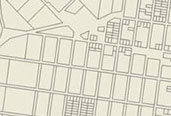History of digital mapping in Queensland
The 1980s saw the major transformation to digitisation of operations, production and output of mapping in Queensland. The major components are described below.

Digitising the cadastre
Significant funding and resources were allocated to develop a Digital Cadastral Data Base (DCDB) covering Queensland. The database saw the digitisation of the best available hard copy cadastral mapping at varying scales. The capture was completed to an agreed standard in 1992. The outcome was a seamless database of the total cadastral network of the state that complied with a range of accuracy ratings. The first hard copy maps using DCDB data were produced in 1985. The accuracy of the DCDB is constantly being improved, and the number of parcels continues to grow. In 2011, the DCDB comprised approximately 2,900,000 property parcels.
Implementing geographic information systems
1986 saw another major advancement in map production and delivery in the Queensland government with the introduction of computer-based geographic information systems (GIS). The software and hardware made it possible to create, store, manipulate, integrate, analyse and output spatial data.
Digitising survey plans
The years 1987 to 1991 saw the development of the Computer Inventory of Survey Plans database (CISP). It was developed for reliable cadastral searching of survey plans in Queensland. The development of CISP meant that survey plans could no longer be continuously updated, as had been the practice. An added benefit of the system was that historical links could be added between survey plans. These links are crucial to the history of land tenure investigations.
Digitising land information
The uptake of digital technology by the mapping and surveying industry during the 1980s and 1990s saw the department devote a great deal of resources to keeping pace with the change required by clients. Software and hardware made it possible for the department to bring together a variety of land related information for the first time. In 1996 the department built the first generation system capable of integrating and querying land information databases. The working model was dubbed the Basic Land Information Network (BLIN) and was accessible to departmental employees only.
The success of BLIN internally saw the release of the second generation system in 2003. The new system branded the SmartMap Information System (SMIS) allowed departmental staff and clients to query a greater number of land information databases and produce customised maps through a single user interface.
Service to clients
These digitisation projects have revolutionised our ability to provide data and products to its clients. With the internet, this digital information can be easily transferred anywhere in the world.
Related links
- Learn about Queensland’s mapping history.
- View images of instruments and equipment used to survey and map Queensland.
- Find out about mapping, data and imagery services.


